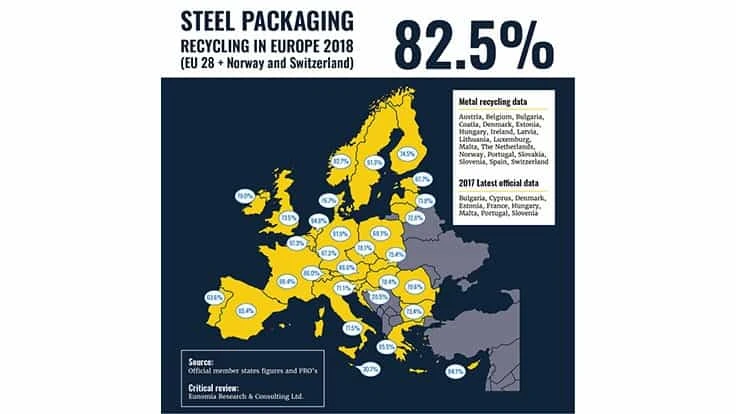
Recycling of steel packaging hit a new all-time high of 82.5 percent in Europe in 2018, according to figures issued by APEAL, the Association of European Producers of Steel for Packaging, Brussels.
APEA says the methodology and data sources it used to calculate the recycling rate have been independently reviewed, audited and certified by energy and waste specialist consultancy, Eunomia.
This new record rate confirms steel as Europe’s most recycled primary[1] packaging material and means that more than 8 out of 10 steel items put on the EU market this year have been recycled into new steel products, APEAL says.
“A recycling increase of 2 percentage points sends a clear message to all stakeholders in the value chain that steel for packaging is a tried, tested and sustainable packaging solution, fit for a 21st century circular economy,” says Alexis Van Maercke, secretary general of APEAL.
“Steel is circular by design. Magnetic properties make steel easy to collect, and steel can be recycled over and over again without any loss of material quality. Today’s rise in recycling rates is largely the result of increased separate collection in countries such as Italy and Poland. As 100 percent of separately collected steel packaging is used to make new products, steel is clearly the best placed of all packaging materials to achieve the aims of the new Circular Economy Action Plan (CEAP 2.0),” he adds.
Despite the increase, APEAL says the industry must continue to improve collection and recycling of steel packaging throughout the EU.
Van Maercke says, “Indeed, we welcomed the European Commission’s ambition to harmonize separate collection of packaging waste streams in the EU, demonstrated in the CEAP 2.0. Separate collection is the best way of guaranteeing high-quality input into recycling operations.”
In 2018, more than 4 million metric tons of CO2 were saved through recycling, the equivalent of taking 870,000 cars off the road for one year.
Latest from Recycling Today
- BMW Group, Encory launch 'direct recycling’ of batteries
- Loom Carbon, RTI International partner to scale textile recycling technology
- Goodwill Industries of West Michigan, American Glass Mosaics partner to divert glass from landfill
- CARI forms federal advocacy partnership
- Monthly packaging papers shipments down in November
- STEEL Act aims to enhance trade enforcement to prevent dumping of steel in the US
- San Francisco schools introduce compostable lunch trays
- Aduro graduates from Shell GameChanger program





